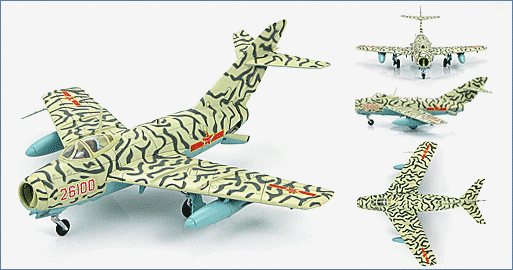Air Power Series>1:72 die-cast display model>MIG-15>HA2415
J-2 (MIG-15 bis) "26100" Chinese Peoples Liberation Army Air Force, Korean War, 1951

General Background
The MiG-15 (NATO name Fagot) was designed from information and technology gathered from captured WWII Germans. The main features of the Mig-15 were its simplicity and swept wings. The MiG-15bis was an improved single-seat fighter with better cannon, fuel capacity, avionics and a Klimov turbojet engine developed using an unlicensed Rolls-Royce Nene engine. All this was put in a strengthened airframe. The Allies were completely surprised when the Mig-15 arrived in Korea and quickly brought about the development of the F-86 Sabre.
The Aircraft
During the Korean War the Chinese "People's Liberation Army Air Force" flew the J-2, their designation for the MiG-15 that were supplied by the USSR. This prompted the Chinese production of several types of aircraft under license from the Soviets. The PLAAF aircraft carry a red star in front of a red band with Chinese characters printed on the red star. These characters stand for eight and one, symbolizing August 1, 1927 the date the People's Liberation Army was formed and the PLAAF is part of.
Specifications :
| Country of origin: | Russia |
| Manufacturer: | Mikoyan-Gurevich |
| Role: | fighter/interceptor |
| Crew: | 1 X pilot |
| Performance | |
| Engine: | 1 X 5,952 pound thrust Klimov VK-1 turbojet |
| Maximum Speed at Sea Level: | 668mph (1,075km/hr) |
| Ceiling: | 50,855ft. |
| Range: | 1,156miles (1860km) |
| Weight | |
| Emptyt: | 8,115lbs. (3,681kg) |
| Max Takeoff: | 13,327lbs. (6,045kg) |
| Dimensions | |
| Wing Span: | 33ft. 0.75in. (10,08m) |
| Length: | 35ft. 7.5in. (10,86m) |
| Height: | 12ft. 1.75in. (3,70m) |
| Armament: | 1 X 37-mm N-37 cannon |
| 2 X 23-mm NS-23 or NR-23 cannon | |
| Up to 1,100 pounds of mixed stores on under-wing hard-points |

